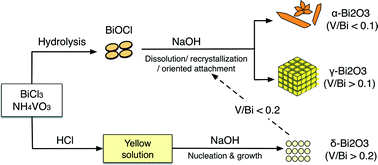Crystallization mechanism and photocatalytic performance of vanadium-modified bismuth oxide through precipitation processes at room temperature†
Abstract
Well-crystallized bismuth oxides (Bi2O3) were synthesized through precipitation processes operating at room temperature. Two synthesis routes were used, which led to Bi2O3 products with completely different phase structures. The crystallization mechanisms of γ-Bi2O3 and δ-Bi2O3 in relation to the synthetic processes were discussed. The role of vanadium (V) ions and the doping limit on the structural modification were also investigated. The photocatalytic efficiencies of the V-modified γ-Bi2O3 and δ-Bi2O3 compared with TiO2 P25 powder were discussed.


 Please wait while we load your content...
Please wait while we load your content...